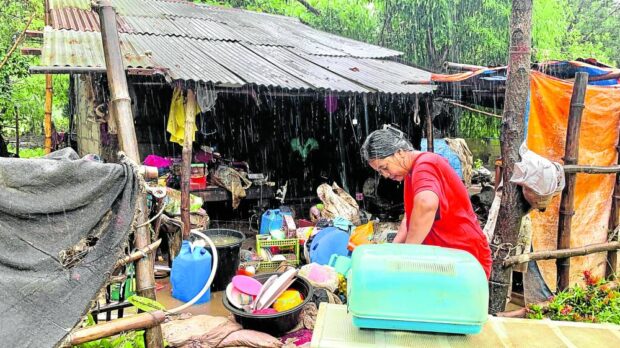
BACK ON THEIR FEET Nora Sarmiento, 51, a resident of San Antonio, Zambales, ignores the rain as she starts cleaning the family’s flood-soaked belongings on Tuesday. Her village of San Miguel was hit by heavy flooding when Typhoon “Egay” (Doksuri) battered central and northern Luzon early this week. —JOANNA ROSE AGLIBOT
SAN ANTONIO, ZAMBALES — Jemmy Sarmiento, 70, and his family have been cleaning up their home in Barangay San Miguel here for almost a week now after it was submerged in floodwater due to the heavy rainfall spawned by Typhoon “Egay” (international name: Doksuri), which battered central and northern Luzon last week.
Sarmiento, 70, who has spent his whole life living in the coastal village, said that the flooding on July 28 was the worst that he experienced.
“After we [had dinner] around 6 p.m., the water suddenly rose. We tried to move our things, but the water still reached them,” Sarmiento told the Inquirer in an interview.
His wife, Nora, 51, recalled that she almost drowned when the flood reached their rooftop.
“I couldn’t swim anymore because it’s too deep. All of our personal belongings were ruined by the flood,” she said.
San Miguel had turned into a lake as heavy rains and flash floods inundated the village at the height of Egay’s onslaught.
Hundreds of houses, including Sarmientos’, were among the worst-hit by the flooding. Some of the affected families were forced to seek temporary shelter at the village day care center due to the widespread flooding.
The Sarmiento couple and other victims of the flood in San Miguel are appealing for help, especially for the elderly and persons with disabilities who need diapers and medicines.
“We are also in need of pillows and blankets because it’s been raining for days and most of our things were soaked in floodwater,” Nora said.
Damage
Incessant rains dumped by Egay and enhanced by the southwest monsoon had left more than P44-million worth of damage to infrastructure and agriculture in Zambales, data from the Provincial Disaster Risk Reduction and Management Council showed on Wednesday.
A damaged dike in Barangay Sta. Fe in nearby San Marcelino town also triggered flooding, destroying the village’s covered court, barangay hall, plaza, health center, day care center, and a single-story building.
In a statement on Tuesday, Gov. Hermogenes Ebdane said the damaged infrastructure in the province would be repaired within a few days.
Though there were no casualties reported in Zambales, close to 4,000 families, or 10,500 people, were affected by the massive flooding.
Ebdane said that the provincial Emergency Operation Center would remain on standby to distribute relief food packs to affected and evacuated families.
Relief goods
In Ilocos Norte province, the nongovernment organization Tropang Angat started distributing relief goods to flood victims.
The group said it responded to the appeal for donations from the coastal communities in the capital city of Laoag, one of the worst-hit areas in the province during the onslaught of Egay.
In a statement, Tropang Angat said the typhoon victims needed clothes, jackets, blankets, kitchen burners, utensils, plates, food items, medicines and toiletries.
Donations, the group said, may also be given in cash to support the group’s “soup kitchen” initiative.
“Thick mud and the slowly receding flood made recovery efforts difficult, but this simple soup kitchen is a step toward easing the immediate needs of the affected residents,” it said.
The Ilocos Norte provincial government has been asking for volunteers to help pack relief goods for the thousands of families affected by Egay.
According to the Department of Social Welfare and Development, at least 57,052 families, or 247,013 people, were affected by the typhoon in the province.
In Benguet, heavy damage to infrastructure and agriculture prompted the provincial board to declare the province under a state of calamity on Wednesday.
Benguet is a major supplier of vegetables to Metro Manila markets.
A July 27 assessment by the Office of Civil Defense in the Cordillera showed that Benguet had the biggest crop damage, worth P5.236 million out of the P50.2 million worth of losses, or about 62,190 metric tons of crops grown by almost 3,000 farmers.
Apart from Benguet, the Cordillera provinces of Abra, Mountain Province and Apayao and Tinoc town in Ifugao had been earlier placed under a state of calamity.